Ehsan Abbasnejad
Towards Higher Effective Rank in Parameter-efficient Fine-tuning using Khatri--Rao Product
Aug 01, 2025Abstract:Parameter-efficient fine-tuning (PEFT) has become a standard approach for adapting large pre-trained models. Amongst PEFT methods, low-rank adaptation (LoRA) has achieved notable success. However, recent studies have highlighted its limitations compared against full-rank alternatives, particularly when applied to multimodal and large language models. In this work, we present a quantitative comparison amongst full-rank and low-rank PEFT methods using a synthetic matrix approximation benchmark with controlled spectral properties. Our results confirm that LoRA struggles to approximate matrices with relatively flat spectrums or high frequency components -- signs of high effective ranks. To this end, we introduce KRAdapter, a novel PEFT algorithm that leverages the Khatri-Rao product to produce weight updates, which, by construction, tends to produce matrix product with a high effective rank. We demonstrate performance gains with KRAdapter on vision-language models up to 1B parameters and on large language models up to 8B parameters, particularly on unseen common-sense reasoning tasks. In addition, KRAdapter maintains the memory and compute efficiency of LoRA, making it a practical and robust alternative to fine-tune billion-scale parameter models.
Learning to Reason and Navigate: Parameter Efficient Action Planning with Large Language Models
May 12, 2025Abstract:The remote embodied referring expression (REVERIE) task requires an agent to navigate through complex indoor environments and localize a remote object specified by high-level instructions, such as "bring me a spoon", without pre-exploration. Hence, an efficient navigation plan is essential for the final success. This paper proposes a novel parameter-efficient action planner using large language models (PEAP-LLM) to generate a single-step instruction at each location. The proposed model consists of two modules, LLM goal planner (LGP) and LoRA action planner (LAP). Initially, LGP extracts the goal-oriented plan from REVERIE instructions, including the target object and room. Then, LAP generates a single-step instruction with the goal-oriented plan, high-level instruction, and current visual observation as input. PEAP-LLM enables the embodied agent to interact with LAP as the path planner on the fly. A simple direct application of LLMs hardly achieves good performance. Also, existing hard-prompt-based methods are error-prone in complicated scenarios and need human intervention. To address these issues and prevent the LLM from generating hallucinations and biased information, we propose a novel two-stage method for fine-tuning the LLM, consisting of supervised fine-tuning (STF) and direct preference optimization (DPO). SFT improves the quality of generated instructions, while DPO utilizes environmental feedback. Experimental results show the superiority of our proposed model on REVERIE compared to the previous state-of-the-art.
Do We Always Need the Simplicity Bias? Looking for Optimal Inductive Biases in the Wild
Mar 13, 2025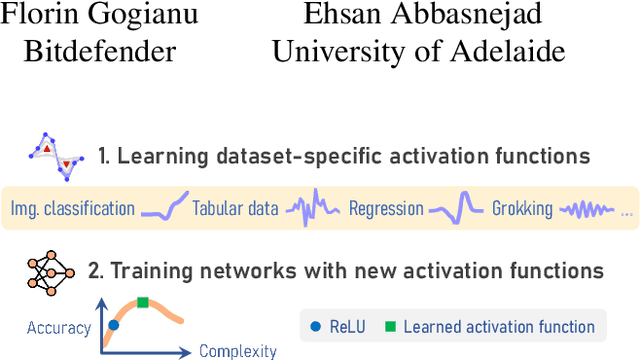

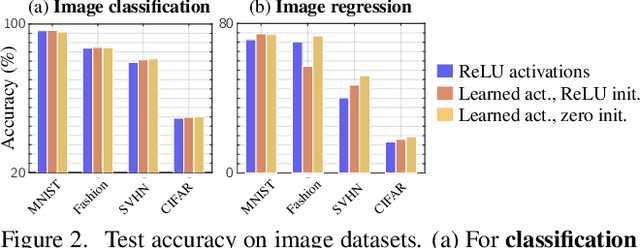
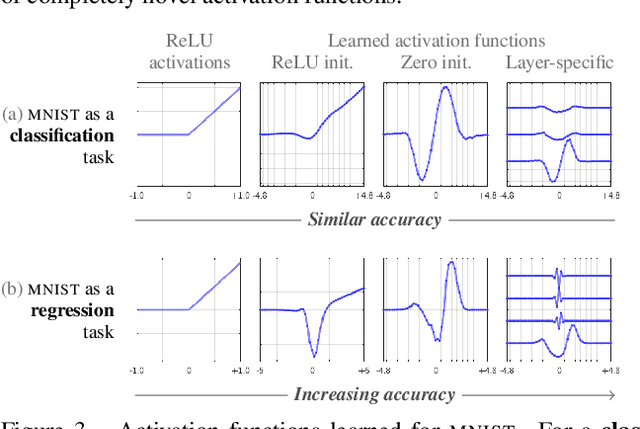
Abstract:Neural architectures tend to fit their data with relatively simple functions. This "simplicity bias" is widely regarded as key to their success. This paper explores the limits of this principle. Building on recent findings that the simplicity bias stems from ReLU activations [96], we introduce a method to meta-learn new activation functions and inductive biases better suited to specific tasks. Findings: We identify multiple tasks where the simplicity bias is inadequate and ReLUs suboptimal. In these cases, we learn new activation functions that perform better by inducing a prior of higher complexity. Interestingly, these cases correspond to domains where neural networks have historically struggled: tabular data, regression tasks, cases of shortcut learning, and algorithmic grokking tasks. In comparison, the simplicity bias induced by ReLUs proves adequate on image tasks where the best learned activations are nearly identical to ReLUs and GeLUs. Implications: Contrary to popular belief, the simplicity bias of ReLU networks is not universally useful. It is near-optimal for image classification, but other inductive biases are sometimes preferable. We showed that activation functions can control these inductive biases, but future tailored architectures might provide further benefits. Advances are still needed to characterize a model's inductive biases beyond "complexity", and their adequacy with the data.
RandLoRA: Full-rank parameter-efficient fine-tuning of large models
Feb 03, 2025Abstract:Low-Rank Adaptation (LoRA) and its variants have shown impressive results in reducing the number of trainable parameters and memory requirements of large transformer networks while maintaining fine-tuning performance. However, the low-rank nature of the weight update inherently limits the representation power of fine-tuned models, potentially compromising performance on complex tasks. This raises a critical question: when a performance gap between LoRA and standard fine-tuning is observed, is it due to the reduced number of trainable parameters or the rank deficiency? This paper aims to answer this question by introducing RandLoRA, a parameter-efficient method that performs full-rank updates using a learned linear combinations of low-rank, non-trainable random matrices. Our method limits the number of trainable parameters by restricting optimization to diagonal scaling matrices applied to the fixed random matrices. This allows us to effectively overcome the low-rank limitations while maintaining parameter and memory efficiency during training. Through extensive experimentation across vision, language, and vision-language benchmarks, we systematically evaluate the limitations of LoRA and existing random basis methods. Our findings reveal that full-rank updates are beneficial across vision and language tasks individually, and even more so for vision-language tasks, where RandLoRA significantly reduces -- and sometimes eliminates -- the performance gap between standard fine-tuning and LoRA, demonstrating its efficacy.
ETAGE: Enhanced Test Time Adaptation with Integrated Entropy and Gradient Norms for Robust Model Performance
Sep 14, 2024Abstract:Test time adaptation (TTA) equips deep learning models to handle unseen test data that deviates from the training distribution, even when source data is inaccessible. While traditional TTA methods often rely on entropy as a confidence metric, its effectiveness can be limited, particularly in biased scenarios. Extending existing approaches like the Pseudo Label Probability Difference (PLPD), we introduce ETAGE, a refined TTA method that integrates entropy minimization with gradient norms and PLPD, to enhance sample selection and adaptation. Our method prioritizes samples that are less likely to cause instability by combining high entropy with high gradient norms out of adaptation, thus avoiding the overfitting to noise often observed in previous methods. Extensive experiments on CIFAR-10-C and CIFAR-100-C datasets demonstrate that our approach outperforms existing TTA techniques, particularly in challenging and biased scenarios, leading to more robust and consistent model performance across diverse test scenarios. The codebase for ETAGE is available on https://github.com/afsharshamsi/ETAGE.
Rethinking State Disentanglement in Causal Reinforcement Learning
Aug 24, 2024



Abstract:One of the significant challenges in reinforcement learning (RL) when dealing with noise is estimating latent states from observations. Causality provides rigorous theoretical support for ensuring that the underlying states can be uniquely recovered through identifiability. Consequently, some existing work focuses on establishing identifiability from a causal perspective to aid in the design of algorithms. However, these results are often derived from a purely causal viewpoint, which may overlook the specific RL context. We revisit this research line and find that incorporating RL-specific context can reduce unnecessary assumptions in previous identifiability analyses for latent states. More importantly, removing these assumptions allows algorithm design to go beyond the earlier boundaries constrained by them. Leveraging these insights, we propose a novel approach for general partially observable Markov Decision Processes (POMDPs) by replacing the complicated structural constraints in previous methods with two simple constraints for transition and reward preservation. With the two constraints, the proposed algorithm is guaranteed to disentangle state and noise that is faithful to the underlying dynamics. Empirical evidence from extensive benchmark control tasks demonstrates the superiority of our approach over existing counterparts in effectively disentangling state belief from noise.
Bayesian Low-Rank LeArning (Bella): A Practical Approach to Bayesian Neural Networks
Jul 30, 2024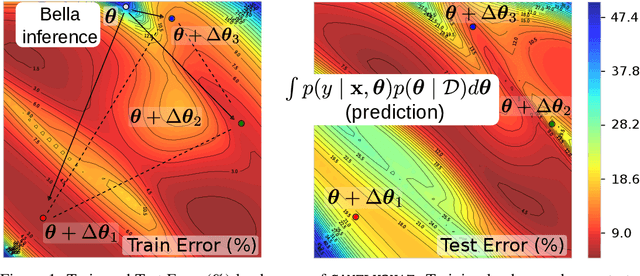



Abstract:Computational complexity of Bayesian learning is impeding its adoption in practical, large-scale tasks. Despite demonstrations of significant merits such as improved robustness and resilience to unseen or out-of-distribution inputs over their non- Bayesian counterparts, their practical use has faded to near insignificance. In this study, we introduce an innovative framework to mitigate the computational burden of Bayesian neural networks (BNNs). Our approach follows the principle of Bayesian techniques based on deep ensembles, but significantly reduces their cost via multiple low-rank perturbations of parameters arising from a pre-trained neural network. Both vanilla version of ensembles as well as more sophisticated schemes such as Bayesian learning with Stein Variational Gradient Descent (SVGD), previously deemed impractical for large models, can be seamlessly implemented within the proposed framework, called Bayesian Low-Rank LeArning (Bella). In a nutshell, i) Bella achieves a dramatic reduction in the number of trainable parameters required to approximate a Bayesian posterior; and ii) it not only maintains, but in some instances, surpasses the performance of conventional Bayesian learning methods and non-Bayesian baselines. Our results with large-scale tasks such as ImageNet, CAMELYON17, DomainNet, VQA with CLIP, LLaVA demonstrate the effectiveness and versatility of Bella in building highly scalable and practical Bayesian deep models for real-world applications.
Knowledge Composition using Task Vectors with Learned Anisotropic Scaling
Jul 03, 2024Abstract:Pre-trained models produce strong generic representations that can be adapted via fine-tuning. The learned weight difference relative to the pre-trained model, known as a task vector, characterises the direction and stride of fine-tuning. The significance of task vectors is such that simple arithmetic operations on them can be used to combine diverse representations from different domains. This paper builds on these properties of task vectors and aims to answer (1) whether components of task vectors, particularly parameter blocks, exhibit similar characteristics, and (2) how such blocks can be used to enhance knowledge composition and transfer. To this end, we introduce aTLAS, an algorithm that linearly combines parameter blocks with different learned coefficients, resulting in anisotropic scaling at the task vector level. We show that such linear combinations explicitly exploit the low intrinsic dimensionality of pre-trained models, with only a few coefficients being the learnable parameters. Furthermore, composition of parameter blocks leverages the already learned representations, thereby reducing the dependency on large amounts of data. We demonstrate the effectiveness of our method in task arithmetic, few-shot recognition and test-time adaptation, with supervised or unsupervised objectives. In particular, we show that (1) learned anisotropic scaling allows task vectors to be more disentangled, causing less interference in composition; (2) task vector composition excels with scarce or no labeled data and is less prone to domain shift, thus leading to better generalisability; (3) mixing the most informative parameter blocks across different task vectors prior to training can reduce the memory footprint and improve the flexibility of knowledge transfer. Moreover, we show the potential of aTLAS as a PEFT method, particularly with less data, and demonstrate that its scalibility.
Synergy and Diversity in CLIP: Enhancing Performance Through Adaptive Backbone Ensembling
May 27, 2024
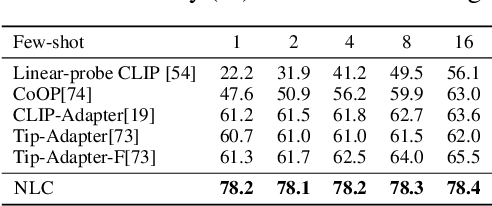

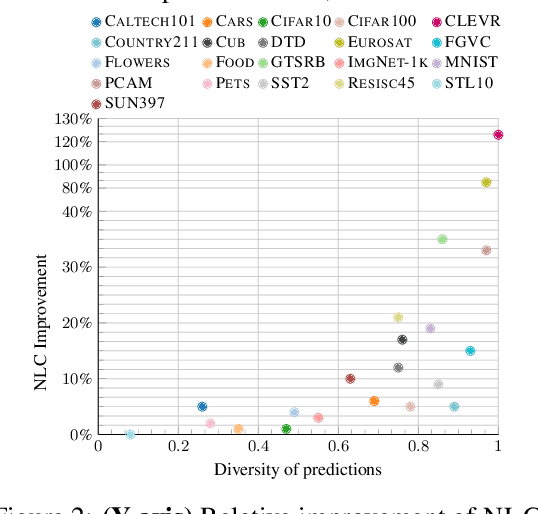
Abstract:Contrastive Language-Image Pretraining (CLIP) stands out as a prominent method for image representation learning. Various architectures, from vision transformers (ViTs) to convolutional networks (ResNets) have been trained with CLIP to serve as general solutions to diverse vision tasks. This paper explores the differences across various CLIP-trained vision backbones. Despite using the same data and training objective, we find that these architectures have notably different representations, different classification performance across datasets, and different robustness properties to certain types of image perturbations. Our findings indicate a remarkable possible synergy across backbones by leveraging their respective strengths. In principle, classification accuracy could be improved by over 40 percentage with an informed selection of the optimal backbone per test example.Using this insight, we develop a straightforward yet powerful approach to adaptively ensemble multiple backbones. The approach uses as few as one labeled example per class to tune the adaptive combination of backbones. On a large collection of datasets, the method achieves a remarkable increase in accuracy of up to 39.1% over the best single backbone, well beyond traditional ensembles
BruSLeAttack: A Query-Efficient Score-Based Black-Box Sparse Adversarial Attack
Apr 08, 2024Abstract:We study the unique, less-well understood problem of generating sparse adversarial samples simply by observing the score-based replies to model queries. Sparse attacks aim to discover a minimum number-the l0 bounded-perturbations to model inputs to craft adversarial examples and misguide model decisions. But, in contrast to query-based dense attack counterparts against black-box models, constructing sparse adversarial perturbations, even when models serve confidence score information to queries in a score-based setting, is non-trivial. Because, such an attack leads to i) an NP-hard problem; and ii) a non-differentiable search space. We develop the BruSLeAttack-a new, faster (more query-efficient) Bayesian algorithm for the problem. We conduct extensive attack evaluations including an attack demonstration against a Machine Learning as a Service (MLaaS) offering exemplified by Google Cloud Vision and robustness testing of adversarial training regimes and a recent defense against black-box attacks. The proposed attack scales to achieve state-of-the-art attack success rates and query efficiency on standard computer vision tasks such as ImageNet across different model architectures. Our artefacts and DIY attack samples are available on GitHub. Importantly, our work facilitates faster evaluation of model vulnerabilities and raises our vigilance on the safety, security and reliability of deployed systems.
 Add to Chrome
Add to Chrome Add to Firefox
Add to Firefox Add to Edge
Add to Edge